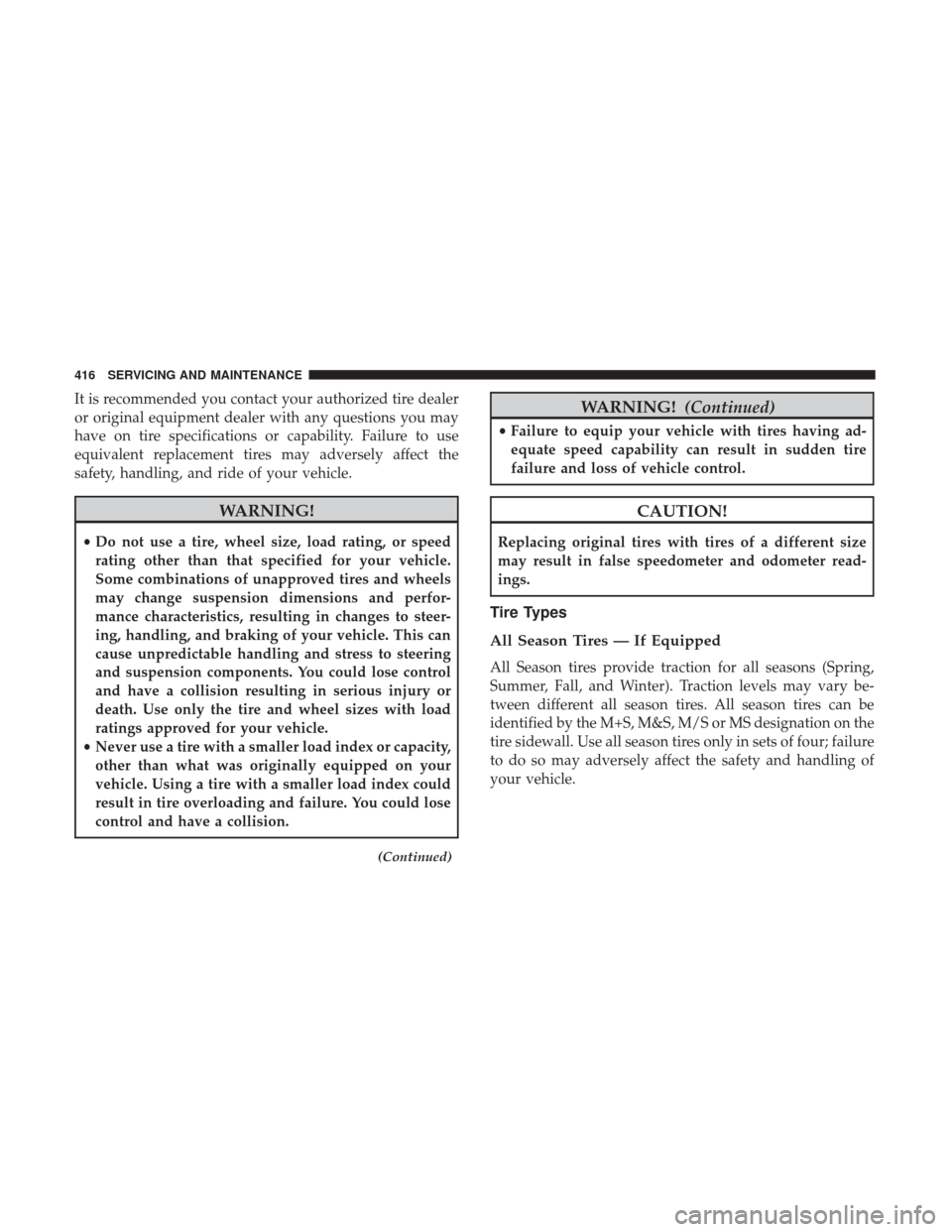Page 126 of 516

•The gauge will likely indicate a higher temperature
when driving in hot weather or up mountain grades. It
should not be allowed to exceed the upper limits of the
normal operating range.
WARNING!
A hot engine cooling system is dangerous. You or
others could be badly burned by steam or boiling
coolant. You may want to call an authorized dealer for
service if your vehicle overheats.
CAUTION!
Driving with a hot engine cooling system could dam-
age your vehicle. If the temperature gauge reads “H”
pull over and stop the vehicle. Idle the vehicle with the
air conditioner turned off until the pointer drops back
into the normal range. If the pointer remains on the
“H”, turn the engine off immediately and call an
authorized dealer for service. 3. Instrument Cluster Display
•The instrument cluster display features a driver-
interactive display. Refer to “Instrument Cluster Dis-
play” in “Getting To Know Your Instrument Panel” for
further information.
4. Fuel Gauge •The fuel gauge shows the level of fuel in the fuel tank
when the ignition is in the ON/RUN position
•
The fuel pump symbol points to the side of the
vehicle where the fuel door is located.
5. Speedometer
•Indicates vehicle speed
INSTRUMENT CLUSTER DISPLAY
Your vehicle may be equipped with an instrument cluster
display, which offers useful information to the driver. With
the ignition in the STOP/OFF position, opening/closing of
a door will activate the display for viewing, and display
the total miles, or kilometers, in the odometer. Your instru-
ment cluster display is designed to display important
information about your vehicle’s systems and features.
Using a driver interactive display located on the instru-
ment panel, your instrument cluster display can show you
how systems are working and give you warnings when
124 GETTING TO KNOW YOUR INSTRUMENT PANEL
Page 177 of 516

Full Off – Four-Wheel Drive Vehicles In 4WD High And
4WD Low Range
The “Full Off” mode is intended for off-highway and
off-road use when ESC stability features could inhibit
vehicle maneuverability due to trail conditions. The “ESC
Off” button is located in the lower switch bank above the
climate control panel. To enter “Full Off” mode, push and
hold the “ESC Off” button for five seconds while the
vehicle is stopped with the engine running. After five
seconds, the ESC Off indicator light will illuminate and an
“ESC Off” message will appear in the odometer.
In this mode, ESC and TCS are turned off (except for the
“limited slip” feature described in the TCS section) until
the vehicle reaches a speed of 40 mph (64 km/h). At speeds
over 40 mph (64 km/h), the system automatically switches
to “Partial Off” mode, described above. When the vehicle
speed returns to less than 35 mph (56 km/h), the ESC
system will return to “Full Off” mode. The ESC OFF
indicator light is always illuminated when ESC is off. To
turn ESC on again, momentarily push the “ESC Off”
button. This will restore the normal “ESC On” mode of
operation.NOTE:
With the ESC switched off, the enhanced vehicle
stability offered by ESC is unavailable. In an emergency
evasive maneuver, the ESC system will not engage to assist
in maintaining stability. “Full Off” mode is only intended
for off-highway or off-road use.
NOTE:
• “Full Off” is the only operating mode for ESC in 4WD
LOW range. The ESC system will be in this mode
whenever the vehicle is started in 4WD LOW range or
the power transfer unit is shifted into 4WD LOW range.
• The “ESC OFF” message will display and a chime will
sound when the gear selector is moved from any posi-
tion to the PARK position and then moved out of the
PARK position. This will occur even if the message was
cleared previously.
Selec-Terrain — If Equipped
On models equipped with Selec-Terrain, the activation of
some driving modes provide partial off or full off of some
active safety systems in order to optimize performance in
specific modes.
Partial or full off of the active safety systems will be
indicated by a light in the instrument cluster.
5
SAFETY 175
Page 418 of 516

It is recommended you contact your authorized tire dealer
or original equipment dealer with any questions you may
have on tire specifications or capability. Failure to use
equivalent replacement tires may adversely affect the
safety, handling, and ride of your vehicle.
WARNING!
•Do not use a tire, wheel size, load rating, or speed
rating other than that specified for your vehicle.
Some combinations of unapproved tires and wheels
may change suspension dimensions and perfor-
mance characteristics, resulting in changes to steer-
ing, handling, and braking of your vehicle. This can
cause unpredictable handling and stress to steering
and suspension components. You could lose control
and have a collision resulting in serious injury or
death. Use only the tire and wheel sizes with load
ratings approved for your vehicle.
• Never use a tire with a smaller load index or capacity,
other than what was originally equipped on your
vehicle. Using a tire with a smaller load index could
result in tire overloading and failure. You could lose
control and have a collision.
(Continued)
WARNING! (Continued)
•Failure to equip your vehicle with tires having ad-
equate speed capability can result in sudden tire
failure and loss of vehicle control.
CAUTION!
Replacing original tires with tires of a different size
may result in false speedometer and odometer read-
ings.
Tire Types
All Season Tires — If Equipped
All Season tires provide traction for all seasons (Spring,
Summer, Fall, and Winter). Traction levels may vary be-
tween different all season tires. All season tires can be
identified by the M+S, M&S, M/S or MS designation on the
tire sidewall. Use all season tires only in sets of four; failure
to do so may adversely affect the safety and handling of
your vehicle.
416 SERVICING AND MAINTENANCE